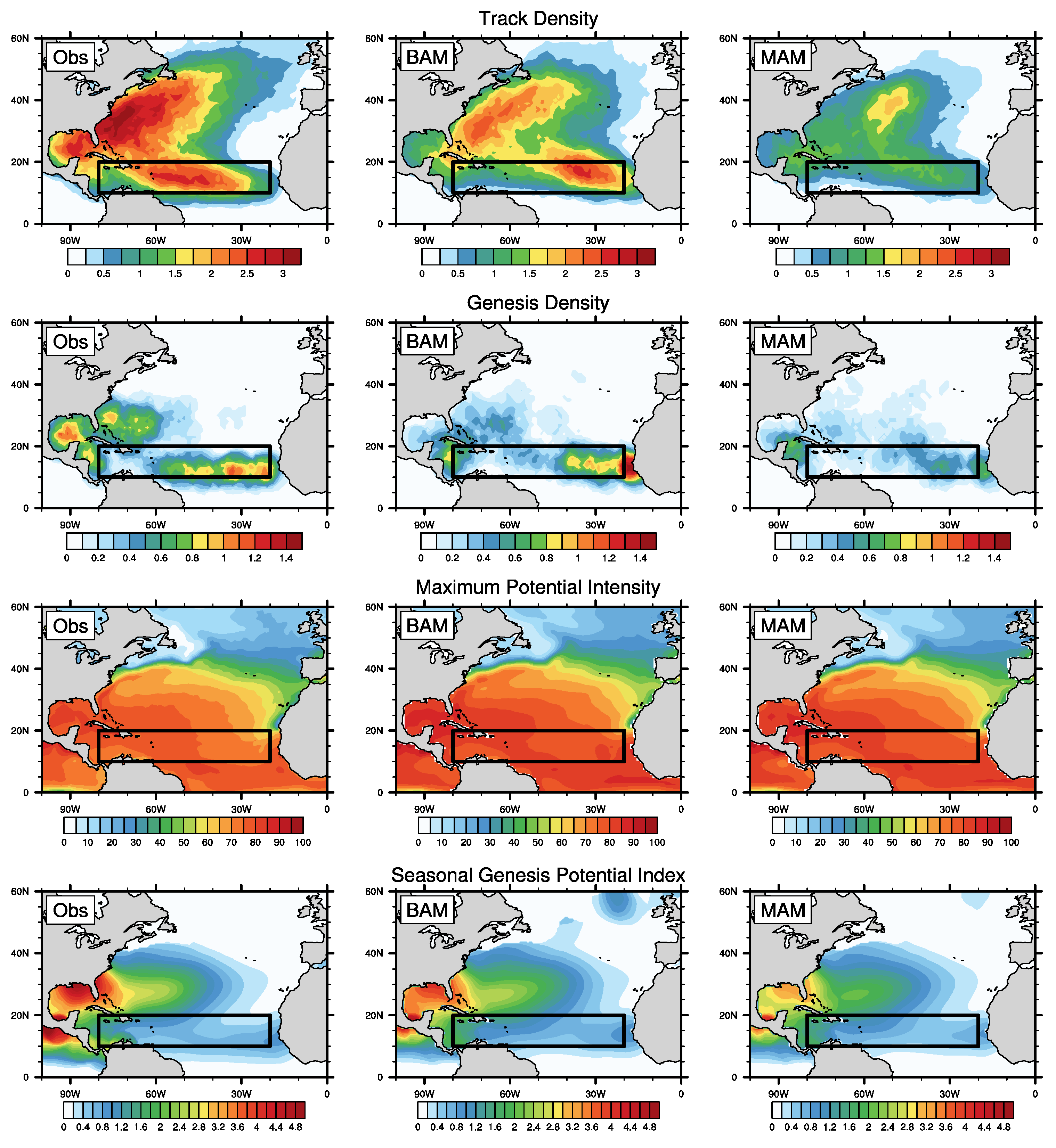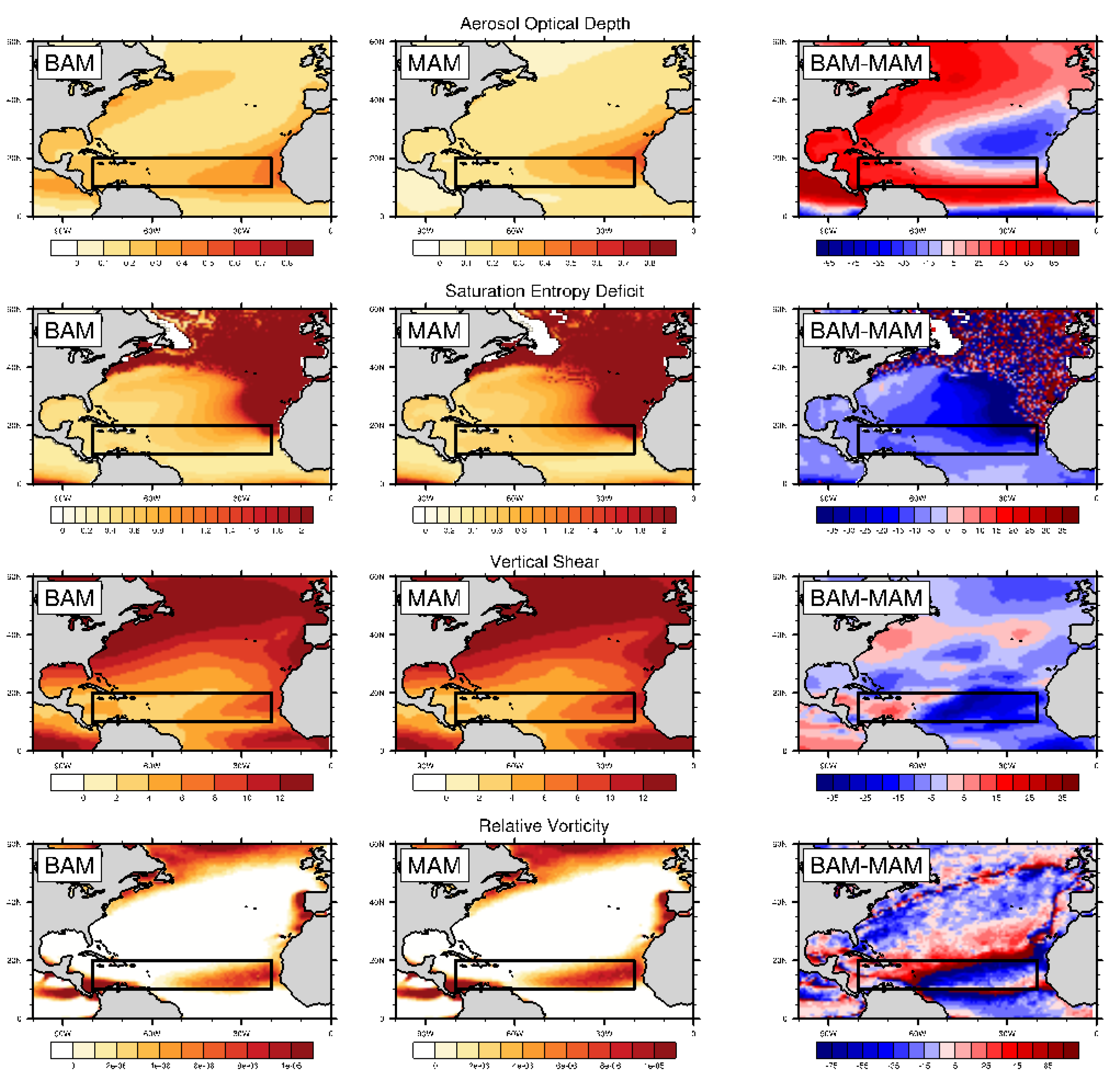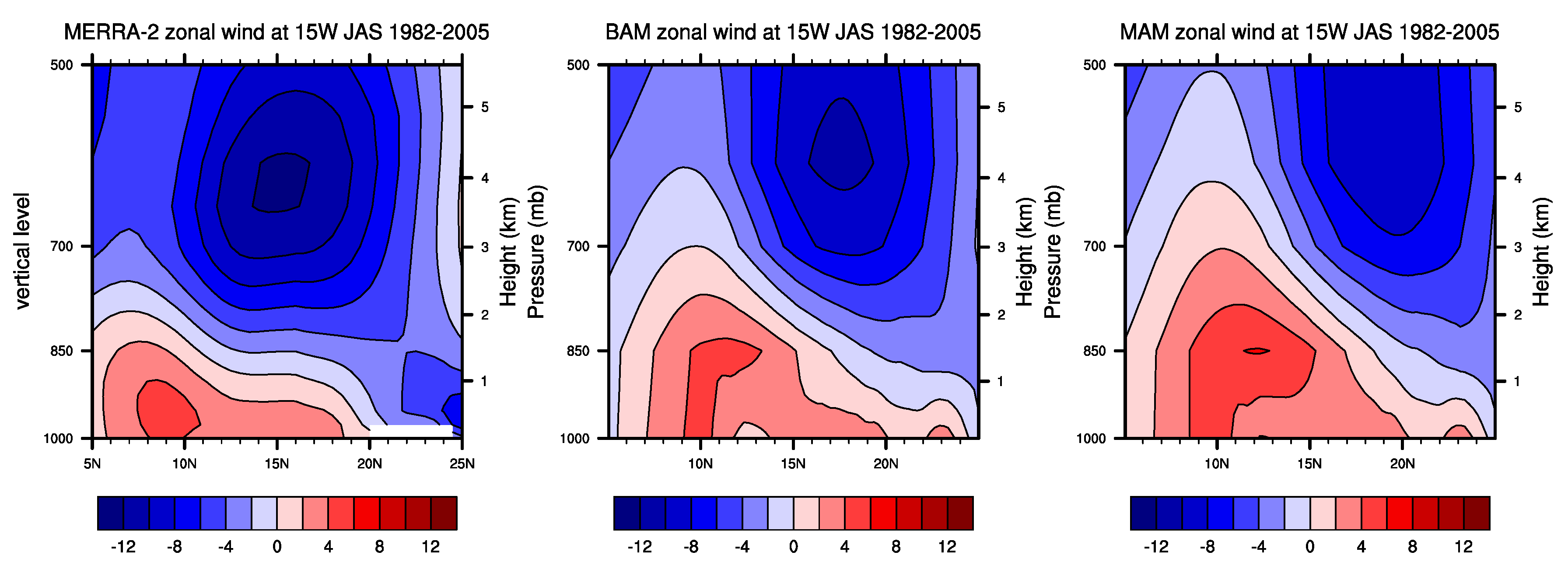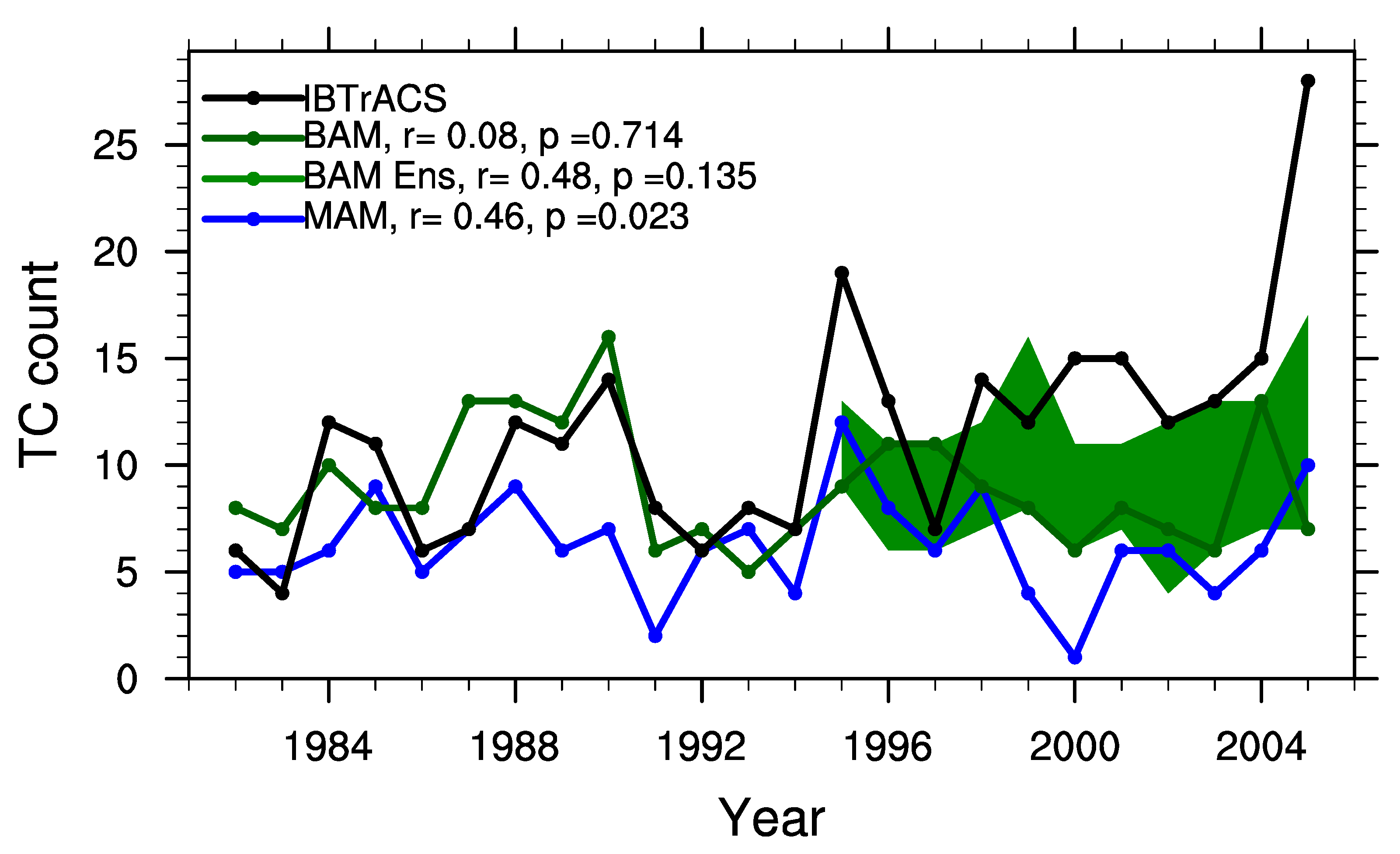Evaluating the Influence of CAM5 Aerosol Configuration on Simulated Tropical Cyclones in the North Atlantic
Abstract
:1. Introduction
2. Data and Methodology
2.1. Model Description
2.2. Observational Datasets
2.3. Methods
3. Results
3.1. Tropical Cyclone Climatology
3.2. Tropical Cyclone Interannual Variability
4. Discussion and Conclusions
Author Contributions
Funding
Institutional Review Board Statement
Informed Consent Statement
Data Availability Statement
Acknowledgments
Conflicts of Interest
References
- Oouchi, K.; Yoshimura, J.; Yoshimura, H.; Mizuta, R.; Kusunoki, S.; Noda, A. Tropical cyclone climatology in a global-warming climate as simulated in a 20 km-mesh global atmospheric model: Frequency and wind intensity analyses. J. Meteorol. Soc. Jpn. 2006, 84, 259–276. [Google Scholar] [CrossRef]
- Bengtsson, L.; Hodges, K.I.; Esch, M.; Keenlyside, N.; Kornblueh, L.; Luo, J.-J.; Yamagata, T. How may tropical cyclones change in a warmer climate? Tellus 2007, 59, 539–561. [Google Scholar] [CrossRef]
- Zhao, M.; Held, I.M.; Lin, S.-J.; Vecchi, G.A. Simulations of Global Hurricane Climatology, Interannual Variability, and Response to Global Warming Using a 50-km Resolution GCM. J. Clim. 2009, 22, 6653–6678. [Google Scholar] [CrossRef]
- Wehner, M.F.; Reed, K.A.; Li, F.; Prabhat; Bacmeister, J.; Chen, C.-T.; Paciorek, C.; Gleckler, P.J.; Sperber, K.R.; Collins, W.D.; et al. The effect of horizontal resolution on simulation quality in the Community Atmospheric Model, CAM5.1. J. Adv. Modeling Earth Syst. 2014, 6, 980–997. [Google Scholar] [CrossRef]
- Bacmeister, J.T.; Reed, K.A.; Hannay, C.; Lawrence, P.; Bates, S.; Truesdale, J.E.; Rosenbloom, N.; Levy, M. Projected changes in tropical cyclone activity under future warming scenarios using a high-resolution climate model. Clim. Change 2018, 146, 547–560. [Google Scholar] [CrossRef]
- Reed, K.A.; Jablonowski, C. Impact of physical parameterizations on idealized tropical cyclones in the Community Atmosphere Model: Impact of Physics on Tropical Cyclones. Geophys. Res. Lett. 2011, 38, L04805. [Google Scholar] [CrossRef]
- Zhao, M.; Held, I.M.; Lin, S.-J. Some Counterintuitive Dependencies of Tropical Cyclone Frequency on Parameters in a GCM. J. Atmos. Sci. 2012, 69, 2272–2283. [Google Scholar] [CrossRef]
- Bacmeister, J.T.; Wehner, M.; Neale, R.B.; Gettelman, A.; Hannay, C.; Lauritzen, P.H.; Caron, J.M.; Truesdale, J.E. Exploratory High-Resolution Climate Simulations using the Community Atmosphere Model (CAM). J. Clim. 2014, 27, 3073–3099. [Google Scholar] [CrossRef]
- Reed, K.A.; Jablonowski, C. Idealized tropical cyclone simulations of intermediate complexity: A test case for AGCMs. J. Adv. Modeling Earth Syst. 2012, 4, M04001. [Google Scholar] [CrossRef]
- Reed, K.A.; Bacmeister, J.T.; Rosenbloom, N.A.; Wehner, M.F.; Bates, S.C.; Lauritzen, P.H.; Truesdale, J.E.; Hannay, C. Impact of the dynamical core on the direct simulation of tropical cyclones in a high-resolution global model: Dynamical core impact on TC Activity. Geophys. Res. Lett. 2015, 42, 3603–3608. [Google Scholar] [CrossRef] [Green Version]
- Shaevitz, D.; Camargo, S.J.; Sobel, A.; Jonas, J.A.; Kim, D.; Kumar, A.; LaRow, T.E.; Lim, Y.; Murakami, H.; Reed, K.; et al. Characteristics of tropical cyclones in high-resolution models in the present climate. J. Adv. Modeling Earth Syst. 2014, 6, 1154–1172. [Google Scholar] [CrossRef]
- Eyring, V.; Bony, S.; Meehl, G.A.; Senior, C.A.; Stevens, B.; Stouffer, R.J.; Taylor, K.E. Overview of the Coupled Model Intercomparison Project Phase 6 (CMIP6) experimental design and organization. Geosci. Model Dev. 2016, 9, 1937–1958. [Google Scholar] [CrossRef]
- Zhao, M.; Golaz, J.-C.; Held, I.M.; Ramaswamy, V.; Lin, S.-J.; Ming, Y.; Ginoux, P.; Wyman, B.; Donner, L.J.; Paynter, D.; et al. Uncertainty in Model Climate Sensitivity Traced to Representations of Cumulus Precipitation Microphysics. J. Clim. 2016, 29, 543–560. [Google Scholar] [CrossRef]
- Reed, K.A.; Bacmeister, J.T.; Huff, J.J.A.; Wu, X.; Bates, S.C.; Rosenbloom, N.A. Exploring the impact of dust on North Atlantic hurricanes in a high-resolution climate model. Geophys. Res. Lett. 2019, 46, 1105–1112. [Google Scholar] [CrossRef]
- Gray, W. The formation of tropical cyclones. Meteorol. Atmos. Phys. 1998, 67, 37–69. [Google Scholar] [CrossRef]
- Emanuel, K.; Nolan, D.S. Tropical Cyclone Activity and the Global Climate System. In Proceedings of the 26th Conference on Hurricanes and Tropical Meteorology, Miami, FL, USA, 3–7 May 2004. [Google Scholar]
- Camargo, S.J.; Emanuel, K.A.; Sobel, A.H. Use of a Genesis Potential Index to Diagnose ENSO Effects on Tropical Cyclone Genesis. J. Clim. 2007, 20, 4819–4834. [Google Scholar] [CrossRef]
- Bruyere, C.L.; Holland, G.J.; Towler, E. Investigating the Use of a Genesis Potential Index for Tropical Cyclones in the North Atlantic Basin. J. Clim. 2012, 25, 8611–8626. [Google Scholar] [CrossRef]
- Gray, W. Atlantic Seasonal Hurricane Frequency. Part I: El Nino and 30 mb Quasi-Biennial Oscillation Influences. Mon. Weather. Rev. 1984, 112, 1649–1668. [Google Scholar] [CrossRef]
- Patricola, C.M.; Chang, P.; Saravanan, R. Degree of simulated suppression of Atlantic tropical cyclones modulated by flavour of El Nino. Nat. Geosci. 2015, 9, 155–160. [Google Scholar] [CrossRef]
- Murakami, H.; Wang, Y.; Yoshimura, H.; Mizuta, R.; Sugi, M.; Shindo, E.; Adachi, Y.; Yukimoto, S.; Hosaka, M.; Kusunoki, S.; et al. Future Changes in Tropical Cyclone Activity Projected by the New High-Resolution MRI-AGCM. J. Clim. 2012, 25, 3237–3260. [Google Scholar] [CrossRef]
- Wehner, M.F.; Prabhat Reed, K.A.; Stone, D.; Collins, W.D.; Bacmeister, J. Resolution Dependence of Future Tropical Cyclone Projections of CAM5.1 in the U.S. CLIVAR Hurricane Working Group Idealized Configurations. J. Clim. 2015, 28, 3905–3925. [Google Scholar] [CrossRef]
- Zhang, W.; Vecchi, G.A.; Murakami, H.; Delworth, T.; Wittenberg, A.T.; Rosati, A.; Underwood, S.; Anderson, W.; Harris, L.; Gudgel, R.; et al. Improved simulation of tropical cyclone responses to ENSO in the western North Pacific in the high-resolution GFDL HiFLOR coupled climate model. J. Clim. 2016, 29, 1391–1415. [Google Scholar] [CrossRef]
- Dunstone, N.J.; Smith, D.M.; Booth, B.B.B.; Hermanson, L.; Eade, R. Anthropogenic aerosol forcing of Atlantic tropical storms. Nat. Geosci. 2013, 6, 534–539. [Google Scholar] [CrossRef]
- De Mott, P.J.; Sassen, K.; Poellot, M.R.; Baumgardner, D.; Rogers, D.C.; Brooks, S.D.; Prenni, A.J.; Kreidenweis, S.M. African dust aerosols as atmospheric ice nuclei: African dust Aerosols as Ice Nuclei. Geophys. Res. Lett. 2003, 30, 1732. [Google Scholar] [CrossRef]
- Carlson, T.N.; Prospero, J.M. The Large-Scale Movement of Saharan Air Outbreaks over the Northern Equatorial Atlantic. J. Appl. Meteorol. 1972, 11, 283–297. [Google Scholar] [CrossRef]
- Dunion, J.P.; Velden, C.S. The Impact of the Saharan Air Layer on Atlantic Tropical Cyclone Activity. Bull. Am. Meteorol. Soc. 2004, 85, 353–365. [Google Scholar] [CrossRef]
- Centeno Delgado, D.C.; Chiao, S. The footprints of Saharan air layer and lightning on the formation of tropical depressions over the eastern Atlantic Ocean. Meteorol. Atmos. Phys. 2015, 127, 17–32. [Google Scholar] [CrossRef]
- Bretl, S.; Reutter, P.; Raible, C.C.; Ferrachat, S.; Poberaj, C.S.; Revell, L.E.; Lohmann, U. The influence of absorbed solar radiation by Saharan dust on hurricane genesis. J. Geophys. Res. Atmos. 2015, 120, 1902–1917. [Google Scholar] [CrossRef]
- Evan, A.T.; Dunion, J.; Foley, J.A.; Heidinger, A.K.; Velden, C.S. New evidence for a relationship between Atlantic tropical cyclone activity and African dust outbreaks. Geophys. Res. Lett. 2006, 33, L19813. [Google Scholar] [CrossRef]
- Strong, J.D.O.; Vecchi, G.A.; Ginoux, P. The climatological effect of Saharan dust on global tropical cyclones in a fully coupled GCM. J. Geophys. Res.-Atmos. 2018, 123, 5538–5559. [Google Scholar] [CrossRef]
- Xian, P.; Klotzbach, P.J.; Dunion, J.P.; Janiga, M.A.; Reid, J.S.; Colarco, P.R.; Kipling, Z. Revisiting the relationship between Atlantic dust and tropical cyclone activity using aerosol optical depth reanalyses: 2003–2018. Atmos. Chem. Phys. 2020, 20, 15357–15378. [Google Scholar] [CrossRef]
- Braun, S.A. Reevaluating the Role of the Saharan Air Layer in Atlantic Tropical Cyclogenesis and Evolution. Mon. Weather. Rev. 2010, 138, 2007–2037. [Google Scholar] [CrossRef]
- Bercos-Hickey, E.; Nathan, T.R.; Chen, S.-H. Saharan dust and the African easterly jet-African easterly wave system: Structure, location and energetics: Saharan Dust and the African Easterly Jet-African Easterly Wave System. Q. J. R. Meteorol. Soc. 2017, 143, 2797–2808. [Google Scholar] [CrossRef]
- Grogan, D.F.P.; Nathan, T.R.; Chen, S.-H. Saharan Dust and the Nonlinear Evolution of the African Easterly Jet–African Easterly Wave System. J. Atmos. Sci. 2017, 74, 27–47. [Google Scholar] [CrossRef]
- Reale, O.; Lau, K.M.; da Silva, A. Impact of Interactive Aerosol on the African Easterly Jet in the NASA GEOS-5 Global Forecasting System. Weather. Forecast. 2011, 26, 504–519. [Google Scholar] [CrossRef]
- Wilcox, E.M.; Lau, K.M.; Kim, K.-M. A northward shift of the North Atlantic Ocean Intertropical Convergence Zone in response to summertime Saharan dust outbreaks: Saharan Dust Outbreaks and Atlantic Itcz. Geophys. Res. Lett. 2010, 37, L04804. [Google Scholar] [CrossRef]
- Pan, B.; Wang, Y.; Hu, J.; Lin, Y.; Hsieh, J.; Logan, T.; Feng, X.; Jiang, J.H.; Yung, Y.L.; Zhang, R. Impacts of Saharan Dust on Atlantic Regional Climate and Implications for Tropical Cyclones. J. Clim. 2018, 31, 7621–7644. [Google Scholar] [CrossRef]
- Reed, K.A.; Jablonowski, C.; Taylor, M.A. Tropical cyclones in the spectral element configuration of the Community Atmosphere Model. Atmos. Sci. Lett. 2012, 13, 303–310. [Google Scholar] [CrossRef]
- Chavas, D.R.; Reed, K.A.; Knaff, J.A. Physical understanding of the tropical cyclone wind-pressure relationship. Nat. Commun. 2017, 8, 1360. [Google Scholar] [CrossRef]
- Zarzycki, C.M.; Jablonowski, C. A multidecadal simulation of Atlantic tropical cyclones using a variable-resolution global atmospheric general circulation model. J. Adv. Modeling Earth Syst. 2014, 6, 805–828. [Google Scholar] [CrossRef]
- Zarzycki, C.M.; Jablonowski, C. Experimental Tropical Cyclone Forecasts Using a Variable-Resolution Global Model. Mon. Weather. Rev. 2015, 143, 4012–4037. [Google Scholar] [CrossRef]
- Stansfield, A.M.; Reed, K.A.; Zarzycki, C.M.; Ullrich, P.A.; Chavas, D.R. Assessing tropical cyclones’ contribution to precipitation over the eastern united states and sensitivity to the variable-resolution domain extent. J. Hydrometeorol. 2020, 21, 1425–1445. [Google Scholar] [CrossRef]
- Hurrell, J.W.; Holland, M.M.; Gent, P.R.; Ghan, S.; Kay, J.E.; Kushner, P.J.; Lamarque, J.-F.; Large, W.G.; Lawrence, D.; Lindsay, K.; et al. The Community Earth System Model A Framework for Collaborative Research. BAMS 2013, 94, 1339–1360. [Google Scholar] [CrossRef]
- Neale, R.; Gettelman, A.; Park, S.; Chen, C.-C.; Lauritzen, P.; Williamson, D.; Rasch, P.J.; Vavrus, S.J.; Taylor, M.A.; Collins, W.D.; et al. Description of the NCAR community atmosphere model (CAM 5.0). NCAR Tech. Note NCAR/TN-464+ STR 2012, 1, 282. [Google Scholar]
- Lin, S.-J.; Rood, R.B. Multidimensional Flux-Form Semi-Lagrangian Transport Schemes. Mon. Weather. Rev. 1996, 124, 2046–2070. [Google Scholar] [CrossRef]
- Lin, S.-J.; Rood, R.B. An explicit flux-form semi-Lagrangian shallow water model on the sphere. Q. J. R. Meteorol. Soc. 1997, 123, 2477–2498. [Google Scholar] [CrossRef]
- Kiehl, J.T.; Schneider, T.L.; Rasch, P.J.; Barth, M.C.; Wong, J. Radiative forcing due to sulfate aerosols from simulations with the National Center for Atmospheric Research Community Climate Model, Version 3. J. Geophys. Res. Atmos. 2000, 105, 1441–1457. [Google Scholar] [CrossRef]
- Easter, R.C.; Ghan, S.; Zhang, Y.; Saylor, R.; Chapman, E.G.; Laulainen, N.S.; Abdul-Razzak, H.; Leung, L.R.; Bian, X.; Zaveri, R. MIRAGE: Model description and evaluation of aerosols and trace gases. J. Geophys. Res. 2004, 109, D20210. [Google Scholar] [CrossRef]
- Ghan, S.J.; Easter, R.C. Impact of cloud-borne aerosol representation on aerosol direct and indirect effects. Atmos. Chem. Phys. 2006, 6, 4163–4174. [Google Scholar] [CrossRef]
- Gates, W.L.; Boyle, J.S.; Covey, C.; Dease, C.G.; Doutriaux, C.M.; Drach, R.S.; Fiorino, M.; Gleckler, P.J.; Hnilo, J.J.; Marlais, S.M.; et al. An overview of the results of the Atmospheric Model Intercomparison Project (AMIP I). Bull. Am. Meteorol. Soc. 1999, 80, 29–55. [Google Scholar] [CrossRef]
- Heidinger, A.K.; Foster, M.J.; Walther, A.; Zhao, X. The pathfinder atmospheres–extended avhrr climate dataset. Bull. Am. Meteorol. Soc. 2014, 95, 909–922. [Google Scholar] [CrossRef]
- Evan, A.T.; Heidinger, A.K.; Pavolonis, M.J. Development of a new over-water Advanced Very High Resolution Radiometer dust detection algorithm. Int. J. Remote Sens. 2006, 27, 3903–3924. [Google Scholar] [CrossRef]
- Bosilovich, M.G.; Akella, S.; Coy, L.; Cullather, R.; Draper, C.; Gelaro, R.; Kovach, R.; Liu, Q.; Molod, A.; Norris, P.; et al. Technical Report Series on Global Modeling and Data Assimilation, Volume 43. MERRA-2; Initial Evaluation of the Climate. Available online: http://ntrs.nasa.gov/search.jsp?R=20160005045 (accessed on 4 January 2016).
- Gelaro, R.; McCarty, W.; Suárez, M.J.; Todling, R.; Molod, A.; Takacs, L.; Randles, C.A.; Darmenov, A.; Bosilovich, M.G.; Reichle, R.; et al. The Modern-Era Retrospective Analysis for Research and Applications, Version 2 (MERRA-2). J. Clim. 2017, 30, 5419–5454. [Google Scholar] [CrossRef]
- Randles, C.A.; Da Silva, A.M.; Buchard, V.; Colarco, P.R.; Darmenov, A.; Govindaraju, R.; Smirnov, A.; Holben, B.; Ferrare, R.; Hair, J.; et al. The MERRA-2 Aerosol Reanalysis, 1980 Onward. Part I: System Description and Data Assimilation Evaluation. J. Clim. 2017, 30, 6823–6850. [Google Scholar] [CrossRef]
- Reale, O.; Lau, K.M.; da Silva, A.; Matsui, T. Impact of assimilated and interactive aerosol on tropical cyclogenesis. Geophys. Res. Lett. 2014, 41, 3282–3288. [Google Scholar] [CrossRef]
- Knapp, K.R.; Kruk, M.C.; Levinson, D.H.; Diamond, H.J.; Neumann, C.J. The international best track archive for climate stewardship (IBTrACS). Bull. Am. Meteorol. Soc. 2010, 91, 363. [Google Scholar] [CrossRef]
- Hodges, K.; Cobb, A.; Vidale, P.L. How Well Are Tropical Cyclones Represented in Reanalysis Datasets? J. Clim. 2017, 30, 5243–5264. [Google Scholar] [CrossRef]
- Done, J.M.; Holland, G.J.; Bruyère, C.L.; Leung, L.R.; Suzuki-Parker, A. Modeling high-impact weather and climate: Lessons from a tropical cyclone perspective. Clim. Change 2015, 129, 381–395. [Google Scholar] [CrossRef]
- Emanuel, K. Sensitivity of Tropical Cyclones to Surface Exchange Coefficients and a Revised Steady-State Model Incorporating Eye Dynamics. J. Atmos. Sci. 1995, 52, 3969–3976. [Google Scholar] [CrossRef]
- Emanuel, K. Tropical cyclone activity downscaled from NOAA-CIRES Reanalysis, 1908–1958. J. Adv. Modeling Earth Syst. 2010, 2, 1. [Google Scholar] [CrossRef]
- Tang, B.; Emanuel, K. A ventilation index for tropical cyclones. Bull. Am. Meteorol. Soc. 2012, 93, 1901–1912. [Google Scholar] [CrossRef]
- Emanuel, K.; Sobel, A. Response of tropical sea surface temperature, precipitation, and tropical cyclone-related variables to changes in global and local forcing. J. Adv. Modeling Earth Syst. 2013, 5, 447–458. [Google Scholar] [CrossRef]
- Cook, K.H. Generation of the African easterly jet and its role in determining West African precipitation. J. Clim. 1999, 12, 1165–1184. [Google Scholar] [CrossRef]
- Roberts, M.J.; Vidale, P.L.; Mizielinski, M.S.; Demory, M.-E.; Schiemann, R.; Strachan, J.; Hodges, K.; Bell, R.; Camp, J. Tropical cyclones in the UPSCALE ensemble of high-resolution global climate models. J. Clim. 2015, 28, 574–596. [Google Scholar] [CrossRef]
- Wehner, M.; Stone, D.; Shiogama, H.; Wolski, P.; Ciavarella, A.; Christidis, N.; Krishnan, H. Early 21st century anthropogenic changes in extremely hot days as simulated by the C20C+ detection and attribution multi-model ensemble. Weather. Clim. Extrem. 2018, 20, 1–8. [Google Scholar] [CrossRef]
- Aryal, Y.N.; Evans, S. Global dust variability explained by drought sensitivity in CMIP6 models. J. Geophys. Res. Earth Surf. 2021, 126, e2021JF006073. [Google Scholar] [CrossRef]








Publisher’s Note: MDPI stays neutral with regard to jurisdictional claims in published maps and institutional affiliations. |
© 2022 by the authors. Licensee MDPI, Basel, Switzerland. This article is an open access article distributed under the terms and conditions of the Creative Commons Attribution (CC BY) license (https://creativecommons.org/licenses/by/4.0/).
Share and Cite
Huff, J.J.A.; Reed, K.A.; Bacmeister, J.T.; Wehner, M.F. Evaluating the Influence of CAM5 Aerosol Configuration on Simulated Tropical Cyclones in the North Atlantic. Climate 2022, 10, 130. https://doi.org/10.3390/cli10090130
Huff JJA, Reed KA, Bacmeister JT, Wehner MF. Evaluating the Influence of CAM5 Aerosol Configuration on Simulated Tropical Cyclones in the North Atlantic. Climate. 2022; 10(9):130. https://doi.org/10.3390/cli10090130
Chicago/Turabian StyleHuff, J. Jacob A., Kevin A. Reed, Julio T. Bacmeister, and Michael F. Wehner. 2022. "Evaluating the Influence of CAM5 Aerosol Configuration on Simulated Tropical Cyclones in the North Atlantic" Climate 10, no. 9: 130. https://doi.org/10.3390/cli10090130
APA StyleHuff, J. J. A., Reed, K. A., Bacmeister, J. T., & Wehner, M. F. (2022). Evaluating the Influence of CAM5 Aerosol Configuration on Simulated Tropical Cyclones in the North Atlantic. Climate, 10(9), 130. https://doi.org/10.3390/cli10090130





